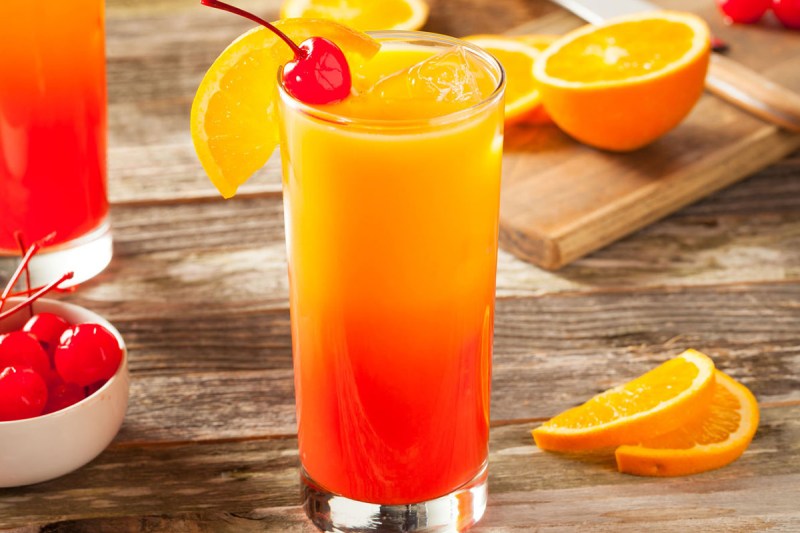For drinks writers and industry types, it’s hard not to have a soft spot for the Tequila Sunrise. The oft-vilified drink is so much more than the subject of a famous soft rock song or what drunk tourists reach for when they’re already halfway drunk.
Related Reading
The Tequila Sunrise is in fact a bit legendary. With origins in the American Southwest almost a century ago, the luminous cocktail would go on to become handpicked by rock stars in the 70s, before falling out of favor with the second wave of the craft cocktail movement. Today, it’s still something of a punching bag. Yet, when made well, it’s a classic that checks all of the boxes — flavorful, fun-loving, even a bit showy.

It all began at a Phoenix hotel in the late 1930s. It was served at the stylish Arizona Biltmore Hotel, likely as an adaptation of something called the Armillita Chico. The early hotel version involved tequila, soda water, lime juice, and creme de cassis. The present-day version was concocted in 1972 at The Trident outside of San Francisco. The eatery was a hot spot for counterculture folks at the time, as well as big name musicians. As the story goes, the drink was served at a private event where the Rolling Stones took a real liking to it. It became so popular with Mick Jagger and Co. that they referred to that year’s tour as the “cocaine and Tequila Sunrise tour.”
The downfall came in the decades after, when the drink featured in little more than tourist trap pool bars. Our palate had shifted away from sweet and syrupy to bright and more adventurous, and there was little room for the Tequila Sunrise. The good news is that it appears to be undergoing a revival. And a surefire way to make sure that happens is by honoring and enhancing the original with the best ingredients and technique possible.
Part of the reason people point fun at the drink is because they’ve never had a properly prepared one. Like the Mai Tai or Piña Colada, the Tequila Sunrise is so often the byproduct of a few cheap ingredients, hastily stitched together and delivered with a “no bad days” kind of mantra. Frankly, that sugar and preservative-driven version of the cocktail does little more than outfit you with a nasty hangover. We can do much, much better.
Others are hard on orange juice, especially in cocktails. That’s fair, if you’re using corner store Tropicana. But if you’re squeezing your own fresh fruit, the results can be wondrous. How do you pull off a perfect Tequila Sunrise? Again, fresh citrus. Go with a high quality orange variety like Valencia. We like a balanced citrus profile, so try blending sweeter juice (Valencia) with a bit of bitter juice like that squeezed from a Seville orange. If you can’t find an orange on the bitter spectrum, plug a little grapefruit juice in, or even some blood orange with a pinch of salt.
A big part of the drink is its signature fade. Don’t overdo it when it comes to stirring. Let the deep hue of the grenadine settle into the drink so you get an upward red-to-gold fade. We like to pour the grenadine over the back of the spoon above the glass so it spreads somewhat evenly over the top before diving to the base of the glass.
Of course, it’s the subject of many great adaptations, too. We especially love plugging in Aperol or Campari in place of grenadine or making a Caribbean version and using rum in place of tequila. You can even use amaretto or mezcal as your base spirit, with tasty results. And don’t shy away from spicy additions like fresh chili peppers or even a tajin rim.
Classic Tequila Sunrise
This standout version from the Death and Co. team eliminates the cloying sweetness by incorporating lime juice and a dialed-in version of house grenadine. Speaking of, we adore this version of grenadine but if you’re not up for micro-additions, use Jack Rudy or Liber & Co.
- 2 oz blanco tequila
- .25 oz house grenadine*
- 4 oz fresh orange juice
- .25 oz fresh lime juice
- 1 orange half wheel and lime wedge for garnish
*House Grenadine: Combine 9 ounces pomegranate juice, 9 ounces unbleached cane sugar, 1.85 grams powdered malic acid, 1.25 grams powdered citric acid, and 0.15 grams Terra Spice orange extract in a blender and process until the sugar dissolves. Transfer to a storage container and refrigerate until ready to use, up to 3 weeks.
Method: Combine tequila, orange juice, and lime juice in Highball glass and add three ice cubes. Stir for 3 seconds. Add the grenadine and don’t stir, so it will settle to the bottom of glass. Garnish with half orange wheel and lime wedge.


